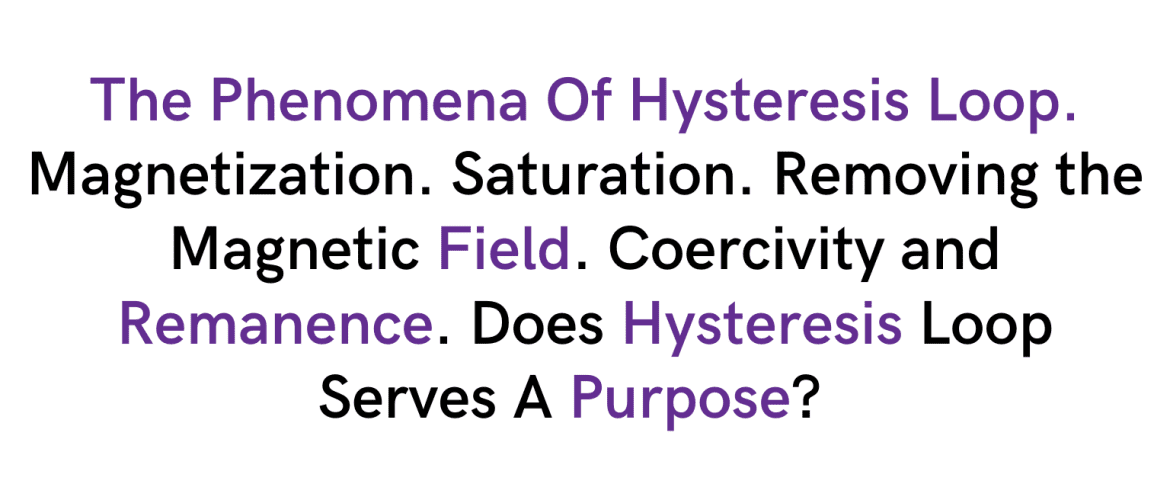Imagine you have a material, like a piece of iron, and you’re interested in how it behaves when you apply and remove a magnetic field to it.
When you do this, you’ll notice something interesting: the way the material responds to the magnetic field isn’t just a straightforward back-and-forth reaction.
Instead, it creates a loop-like pattern when you plot its behavior on a graph.
This loop is called a “hysteresis loop.”
Now, let’s break down what’s happening:
Magnetization
When you start by applying a magnetic field to the iron, it begins to become magnetized.
This means it turns into a magnet itself, and it aligns its tiny magnetic particles (atoms or domains) in the same direction as the applied magnetic field.
As you increase the strength of the magnetic field, the material becomes more and more magnetized, and you’ll see this on the graph as it goes up.
Saturation
Eventually, you’ll reach a point where the material can’t get any more magnetized.
It’s as if all the magnetic particles are already lined up, and no matter how strong the magnetic field gets, it won’t make the material any more magnetic.
This point is called “saturation,” and you’ll notice it as a flat part of the loop at the top.
Removing the Magnetic Field
Now, if you start decreasing the strength of the magnetic field, something interesting happens.
The material doesn’t instantly lose all its magnetization. It holds on to some of it.
This is the key part of the hysteresis loop.
Even when you’ve completely removed the magnetic field, the material still remains somewhat magnetized.
This is shown as the curve bending downwards.
Coercivity and Remanence
As you continue to reduce the magnetic field’s strength, you’ll reach a point where the material finally lets go of its magnetization, and it becomes non-magnetic again.
This is called “coercivity.” The level of magnetization the material retains after the field is removed is called “remanence.”
Does Hysteresis Loop Serves A Purpose?
Yes, hysteresis loops serve several important purposes in various practical applications.
Here are a few examples:
Magnetic Materials for Transformers and Inductors
In devices like transformers and inductors, magnetic materials with hysteresis properties are used to efficiently store and transfer energy.
The hysteresis loop ensures that the material remains magnetized even after the applied magnetic field changes direction.
This property helps in controlling and stabilizing the flow of electrical energy in these devices.
Magnetic Storage
Hysteresis loops are crucial in magnetic storage devices, such as hard drives.
The ability of a material to retain magnetization even after the magnetic field is removed allows for the encoding of data in the form of magnetic domains.
This information can be written, read, and erased, forming the basis for digital data storage.
Magnetic Sensors
Some types of magnetic sensors, like Hall effect sensors, rely on the hysteresis behavior of materials.
These sensors can detect changes in magnetic fields, and the hysteresis loop helps maintain a stable reading even in the presence of minor fluctuations in the field.
Magnetic Switches and Relays
Hysteresis loops are utilized in magnetic switches and relays to create stable on/off states.
The loop ensures that once the switch is turned on (magnetized), it remains in that state until a specific condition is met to turn it off (demagnetized).
This is useful in various control and automation applications.
Magnetic Materials in Speakers and Microphones
In audio devices like speakers and microphones, hysteresis properties can be important for reproducing sound accurately.
The material’s ability to maintain magnetization can impact the response and quality of sound.
To Summarize
So, in simple terms, a hysteresis loop shows how a material responds to a changing magnetic field.
It illustrates that the material doesn’t instantly respond to changes but has a memory of its magnetic history.
It stays partially magnetized even after the magnetic field is removed and only fully demagnetizes when the field is reduced to a certain point.
This phenomenon is important in many applications, like in magnetic materials used in transformers, magnetic storage devices (like hard drives), and even in some everyday items like refrigerator magnets.
hysteresis loops serve a purpose in various technologies and devices by providing a stable and controllable response to changing magnetic fields. They are a fundamental aspect of how certain materials behave and are harnessed in many practical applications across industries.




Leave A Comment